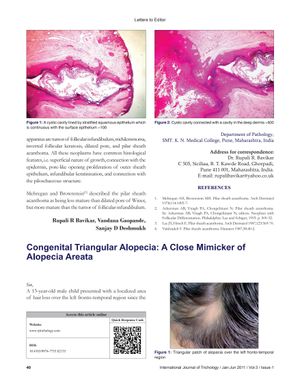Congenital Triangular Alopecia: A Close Mimicker of Alopecia Areata
January 2011
in “
International Journal of Trichology
”

TLDR CTA is often mistaken for AA but doesn't respond to steroids and may require hair transplantation.
The document discusses a case of congenital triangular alopecia (CTA), a condition that can be easily mistaken for alopecia areata (AA), an autoimmune disorder. CTA, also known as temporal triangular alopecia or Brauer nevus, is a non-scarring form of hair loss that typically presents as a triangular patch of alopecia, often noticed in childhood when vellus hair is replaced by terminal hair. The case presented involves a 13-year-old male who had a persistent patch of hair loss since the age of 3, which did not respond to treatments for AA, leading to the diagnosis of CTA. The document emphasizes that CTA does not respond to steroids because it involves normal skin rather than inflamed skin, and it is important to distinguish CTA from AA to avoid unnecessary steroid use. Hair transplantation is suggested as a potential treatment option. The document aims to raise awareness among clinicians about CTA to prevent misdiagnosis and inappropriate treatment.
